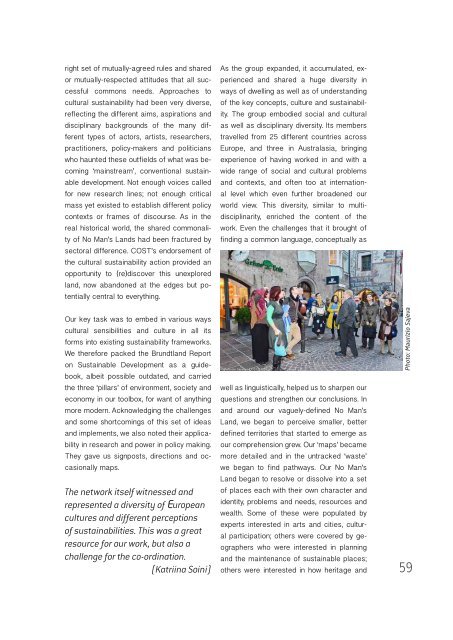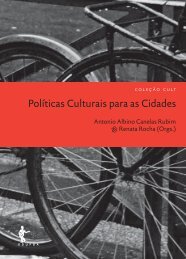Culture in for and as Sustainable Development
YIGflg
YIGflg
Create successful ePaper yourself
Turn your PDF publications into a flip-book with our unique Google optimized e-Paper software.
ight set of mutually-agreed rules <strong>and</strong> shared<br />
or mutually-respected attitudes that all successful<br />
commons needs. Approaches to<br />
cultural susta<strong>in</strong>ability had been very diverse,<br />
reflect<strong>in</strong>g the different aims, <strong>as</strong>pirations <strong>and</strong><br />
discipl<strong>in</strong>ary backgrounds of the many different<br />
types of actors, artists, researchers,<br />
practitioners, policy-makers <strong>and</strong> politicians<br />
who haunted these outfields of what w<strong>as</strong> becom<strong>in</strong>g<br />
‘ma<strong>in</strong>stream’, conventional susta<strong>in</strong>able<br />
development. Not enough voices called<br />
<strong>for</strong> new research l<strong>in</strong>es; not enough critical<br />
m<strong>as</strong>s yet existed to establish different policy<br />
contexts or frames of discourse. As <strong>in</strong> the<br />
real historical world, the shared commonality<br />
of No Man’s L<strong>and</strong>s had been fractured by<br />
sectoral difference. COST’s endorsement of<br />
the cultural susta<strong>in</strong>ability action provided an<br />
opportunity to (re)discover this unexplored<br />
l<strong>and</strong>, now ab<strong>and</strong>oned at the edges but potentially<br />
central to everyth<strong>in</strong>g.<br />
Our key t<strong>as</strong>k w<strong>as</strong> to embed <strong>in</strong> various ways<br />
cultural sensibilities <strong>and</strong> culture <strong>in</strong> all its<br />
<strong>for</strong>ms <strong>in</strong>to exist<strong>in</strong>g susta<strong>in</strong>ability frameworks.<br />
We there<strong>for</strong>e packed the Brundtl<strong>and</strong> Report<br />
on Susta<strong>in</strong>able <strong>Development</strong> <strong>as</strong> a guidebook,<br />
albeit possible outdated, <strong>and</strong> carried<br />
the three ‘pillars’ of environment, society <strong>and</strong><br />
economy <strong>in</strong> our toolbox, <strong>for</strong> want of anyth<strong>in</strong>g<br />
more modern. Acknowledg<strong>in</strong>g the challenges<br />
<strong>and</strong> some shortcom<strong>in</strong>gs of this set of ide<strong>as</strong><br />
<strong>and</strong> implements, we also noted their applicability<br />
<strong>in</strong> research <strong>and</strong> power <strong>in</strong> policy mak<strong>in</strong>g.<br />
They gave us signposts, directions <strong>and</strong> occ<strong>as</strong>ionally<br />
maps.<br />
The network itself witnessed <strong>and</strong><br />
represented a diversity of European<br />
cultures <strong>and</strong> different perceptions<br />
of susta<strong>in</strong>abilities. This w<strong>as</strong> a great<br />
resource <strong>for</strong> our work, but also a<br />
challenge <strong>for</strong> the co-ord<strong>in</strong>ation.<br />
(Katri<strong>in</strong>a So<strong>in</strong>i)<br />
As the group exp<strong>and</strong>ed, it accumulated, experienced<br />
<strong>and</strong> shared a huge diversity <strong>in</strong><br />
ways of dwell<strong>in</strong>g <strong>as</strong> well <strong>as</strong> of underst<strong>and</strong><strong>in</strong>g<br />
of the key concepts, culture <strong>and</strong> susta<strong>in</strong>ability.<br />
The group embodied social <strong>and</strong> cultural<br />
<strong>as</strong> well <strong>as</strong> discipl<strong>in</strong>ary diversity. Its members<br />
travelled from 25 different countries across<br />
Europe, <strong>and</strong> three <strong>in</strong> Austral<strong>as</strong>ia, br<strong>in</strong>g<strong>in</strong>g<br />
experience of hav<strong>in</strong>g worked <strong>in</strong> <strong>and</strong> with a<br />
wide range of social <strong>and</strong> cultural problems<br />
<strong>and</strong> contexts, <strong>and</strong> often too at <strong>in</strong>ternational<br />
level which even further broadened our<br />
world view. This diversity, similar to multidiscipl<strong>in</strong>arity,<br />
enriched the content of the<br />
work. Even the challenges that it brought of<br />
f<strong>in</strong>d<strong>in</strong>g a common language, conceptually <strong>as</strong><br />
well <strong>as</strong> l<strong>in</strong>guistically, helped us to sharpen our<br />
questions <strong>and</strong> strengthen our conclusions. In<br />
<strong>and</strong> around our vaguely-def<strong>in</strong>ed No Man’s<br />
L<strong>and</strong>, we began to perceive smaller, better<br />
def<strong>in</strong>ed territories that started to emerge <strong>as</strong><br />
our comprehension grew. Our ‘maps’ became<br />
more detailed <strong>and</strong> <strong>in</strong> the untracked ‘w<strong>as</strong>te’<br />
we began to f<strong>in</strong>d pathways. Our No Man’s<br />
L<strong>and</strong> began to resolve or dissolve <strong>in</strong>to a set<br />
of places each with their own character <strong>and</strong><br />
identity, problems <strong>and</strong> needs, resources <strong>and</strong><br />
wealth. Some of these were populated by<br />
experts <strong>in</strong>terested <strong>in</strong> arts <strong>and</strong> cities, cultural<br />
participation; others were covered by geographers<br />
who were <strong>in</strong>terested <strong>in</strong> plann<strong>in</strong>g<br />
<strong>and</strong> the ma<strong>in</strong>tenance of susta<strong>in</strong>able places;<br />
others were <strong>in</strong>terested <strong>in</strong> how heritage <strong>and</strong><br />
Photo: Maurizio Sajeva<br />
59




